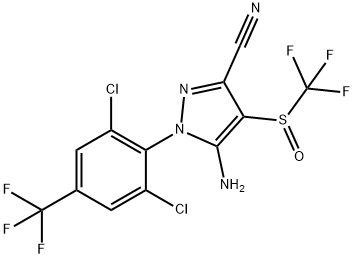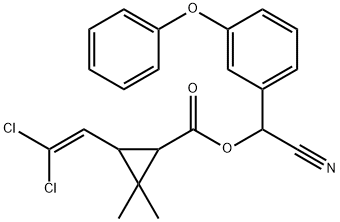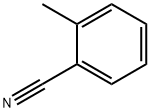Fipronil , 10mMinDMSO , 120068-37-3
CAS NO.:120068-37-3
Empirical Formula: C12H4Cl2F6N4OS
Molecular Weight: 437.15
MDL number: MFCD00867812
EINECS: 424-610-5
| Pack Size | Price | Stock | Quantity |
| 1ml | RMB159.20 | In Stock |
|
| others | Enquire |
PRODUCT Properties
| Melting point: | 200-201°C |
| Boiling point: | 510.1±50.0 °C(Predicted) |
| Density | 1.477-1.626 |
| vapor pressure | 3.7×10-7 Pa (25 °C) |
| storage temp. | Keep in dark place,Sealed in dry,2-8°C |
| solubility | DMSO: 250 mg/mL (571.89 mM) |
| form | Solid |
| Water Solubility | 1.9-2.4 mg 1l-1 (20 °C) |
| pka | -5.86±0.20(Predicted) |
| color | White to Light yellow |
| λmax | 208nm(H2O)(lit.) |
| Merck | 14,4085 |
| BRN | 8090115 |
| LogP | 4.000 |
| CAS DataBase Reference | 120068-37-3(CAS DataBase Reference) |
| EPA Substance Registry System | Fipronil (120068-37-3) |
Description and Uses
Fipronil is a white powder with a mouldy odour. It has a low solubility in water and is a slow-acting poison. It does not bind strongly with soil, and the half-life of fipronil– sulphone is 34 days. Fipronil is a broadspectrum insecticide of the phenylpyrazole group. Fipronil was first used extensively for the control of ants, beetles, cockroaches, fleas; ticks, termites, mole crickets, thrips, rootworms, weevils, flea of pets, field pest of corn, golf courses, and commercial turf, and other insects. Fipronil was first used in the United States in 1996. Fipronil is a topical insecticide. It kills adult fleas and larvae, ticks, and chewing lice. As a liquid, fipronil is applied on the back side skin of dogs and cats. Reports indicate that some animals do become hypersensitive (allergic) to fipronil.
antifungal
Safety
| Symbol(GHS) |    GHS06,GHS08,GHS09 |
| Signal word | Danger |
| Hazard statements | H301+H311+H331-H372-H410 |
| Precautionary statements | P273-P280-P301+P310-P302+P352+P312-P304+P340+P311-P314 |
| Hazard Codes | T,N |
| Risk Statements | 23/24/25-48/25-50/53-55-57-36 |
| Safety Statements | 26-36/37/39-45-60-61-36/37-28 |
| RIDADR | 2588 |
| WGK Germany | 3 |
| RTECS | UQ4430250 |
| HazardClass | 6.1(b) |
| PackingGroup | III |
| HS Code | 29331990 |
| Hazardous Substances Data | 120068-37-3(Hazardous Substances Data) |
| Toxicity | LD50 in rats (mg/kg): 100 orally; >2000 dermally (Colliot); in mice (mg/kg): 32 i.p. (Cole) |




